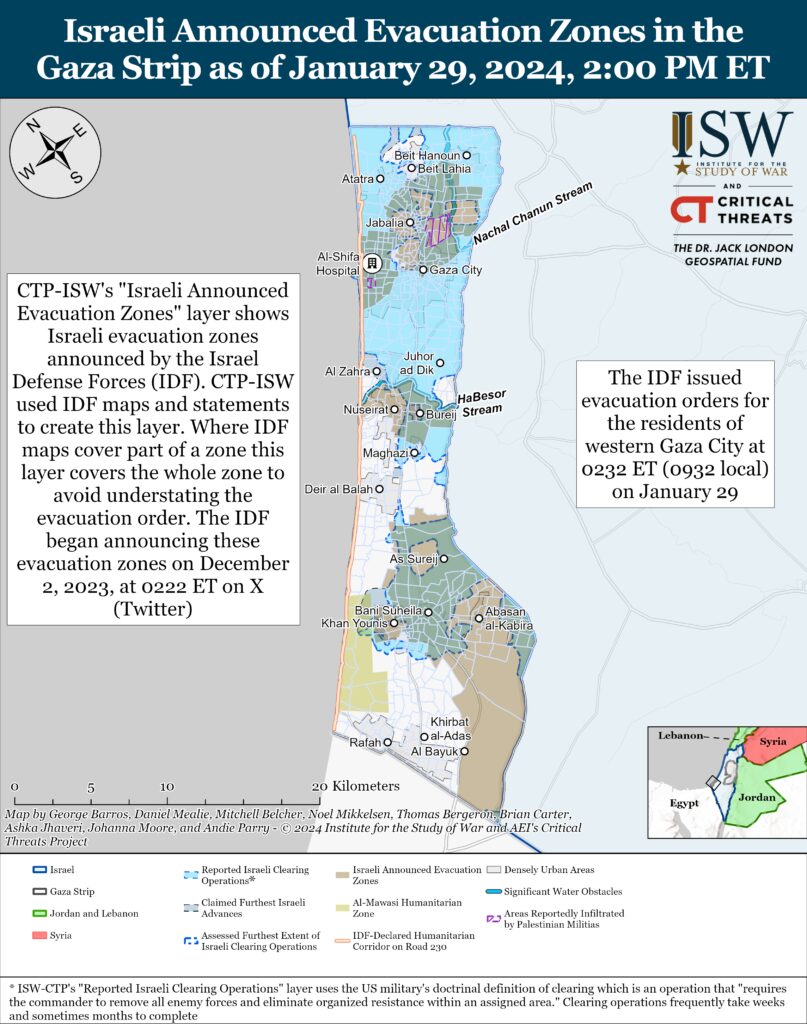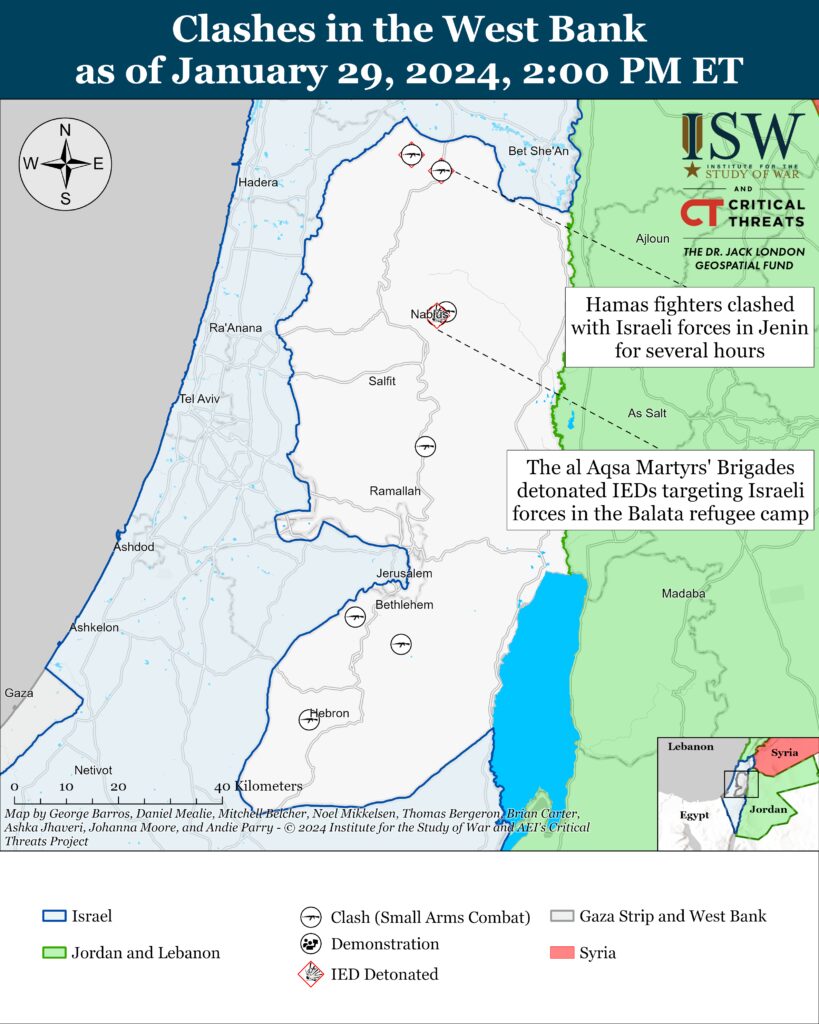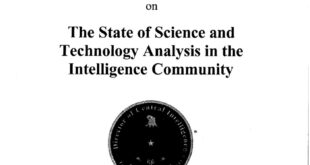Key Takeaways:
- Jordan: Iran and its proxies are advancing an information operation to obfuscate the origin of the January 28 attack that killed three US service members in Jordan. Statements from Kataib Hezbollah before the attack and Iraqi militia actions afterward suggest that the attack came from Iraq.
- Northern Gaza Strip: Palestinian militias are continuing to conduct attacks against Israeli forces in the northern Gaza Strip as they infiltrate previously cleared areas.
- Central Gaza Strip: The IDF reported that the Nahal Brigade (assigned to the 162nd Division) raided a building and seized a weapons cache in an unspecified area of the central Strip.
- Southern Gaza Strip: The 89th Commando Brigade (assigned to the IDF 98th Division) captured Palestinian militia weapons caches and killed five Palestinian fighters in western Khan Younis.
- West Bank: Israeli forces conducted raids, detained ”wanted individuals,” and captured weapons during operations in the West Bank.
- Southern Lebanon and Golan Heights: LH claimed 13 attacks targeting Israeli forces and border outposts. LH has claimed on average six attacks per day in January 2024.
- Syria: Unspecified militants conducted an attack targeting US forces at al Shaddadi, Hasakah Province, Syria.

Gaza Strip
Axis of Resistance campaign objectives:
Erode the will of the Israeli political establishment and public to launch and sustain a major ground operation into the Gaza Strip
Degrade IDF material and morale around the Gaza Strip.The Israel Defense Forces resumed operations in western Gaza City on January 28 and 29. Local Palestinian journalists and activists reported at 1832 ET (0132 local on January 29) on January 28 that the IDF moved into areas near al Shifa Hospital and the Rimal, Nasser, and Wahda neighborhoods.[i] A Palestinian journalist also said that the IDF conducted airstrikes and fought engagements with Palestinian militias in the Zaytoun, Tel al Hawa, and Sheikh Radwan areas.[ii] The IDF issued evacuation orders for the residents of western Gaza City at 0232 ET (0932 local) on January 29.[iii] The IDF reported at 1402 ET on January 29 (2102 local) that “during the night hours [local time],” the IDF moved into western Gaza City from the north, south, and west.[iv] The IDF said on January 29 that the 5th Brigade (assigned to the 143rd Division) captured Palestinian militia weapons caches, tunnels, and observation posts, during the operation in al Shati Camp.[v]

Palestinian militias infiltrated some areas in southwestern Gaza City, including Tel al Hawa, on or before January 19. Palestinian journalists reported that Palestinian fighters engaged Israeli forces in southwestern Gaza City on January 19 and 21.[vi] CTP-ISW defines infiltration as the process by which “an attacking force conducts undetected movement through or into an area occupied by [opposing] forces to occupy a position of advantage behind those [opposing] positions while exposing only small elements to [opposing] defensive fires.”[vii]
Palestinian militias are continuing to conduct attacks against Israeli forces in the northern Gaza Strip as they infiltrate previously cleared areas. The Palestinian Islamic Jihad (PIJ) claimed that it conducted an indirect fire attack targeting a “major [IDF] logistical support” position near the Sudaniya area, north of Shati camp.[viii] PIJ published a video that did not show the results of the attack.[ix] The IDF has maintained a position near Sudaniya since the beginning of the war. Fatah’s self-affiliated military wing, the al Aqsa Martyrs’ Brigade, fired small arms targeting Israeli forces northeast of Sudaniya, near al Atatra, on January 27.[x]

The IDF continued clearing operations in the central Gaza Strip on January 29. The IDF reported that the Nahal Brigade (assigned to the 162nd Division) raided a building and seized a weapons cache in an unspecified area of the central Strip.[xi] The IDF said that the brigade killed “dozens” of Palestinian fighters on January 28 and 29.
The IDF’s 98th Division captured a major tunnel complex under Bani Suheila that served as a command-and-control site for the Hamas Eastern Khan Younis Battalion on January 28.[xii] The IDF reported that the Eastern Khan Younis Battalion commander used the tunnel on October 7 to direct the attack. The system included an operations center, a “battalion combat management” facility, and sleeping quarters for Hamas commanders and fighters.
The IDF continued clearing operations in western Khan Younis on January 29. The 89th Commando Brigade (assigned to the IDF 98th Division) captured Palestinian militia weapons caches and killed five Palestinian fighters in western Khan Younis.[xiii] The 35th Paratroops Brigade (assigned to the IDF 98th Division) also killed four Palestinian fighters before the fighters could attack IDF forces near the al Amal Hospital.[xiv]
Palestinian fighters attempted to defend against Israeli clearing operations in western Khan Younis on January 29. Palestinian Islamic Jihad detonated an explosively formed penetrator (EFP) targeting Israeli armor near Hassan Salama Mosque in western Khan Younis on January 29.[xv] Other Palestinian militias, including Hamas and the al Aqsa Martyrs’ Brigades, continued to target Israeli forces in western Khan Younis with small arms and shoulder-fired rockets.[xvi]
Hamas’ military wing fired one rocket salvo targeting Tel Aviv on January 29.[xvii] Hamas last conducted a rocket attack on January 18.[xviii] The group last targeted Tel Aviv on January 8.[xix]
Israeli Defense Minister Yoav Gallant told US Ambassador to Israel Jack Lew and US Envoy for Humanitarian Affairs David Satterfield that he would not allow the rebuilding of Israeli settlements in the Gaza Strip.[xx] Israeli and US officials told Axios that Lew and Satterfield asked Gallant if Israel’s one-kilometer security buffer zone in the Gaza Strip “was a basis for settlements.”[xxi] Gallant responded that the buffer zone “would be temporary and for security purposes only.”[xxii] A senior Israeli official told Axios that the IDF operations branch head said during that meeting that allowing Israeli civilians to enter the buffer zone would “contradict the security purpose.”[xxiii]

Recorded reports of attacks; CTP-ISW cannot independently verify impact.
West Bank
Axis of Resistance campaign objectives:
Draw IDF assets and resources toward the West Bank and fix them thereIsraeli forces clashed with Palestinian militias 14 times across the West Bank on January 29.[xxiv] Israeli forces conducted raids, detained ”wanted individuals,” and captured weapons during operations in the West Bank.[xxv]


This map is not an exhaustive depiction of clashes and demonstrations in the West Bank.
Southern Lebanon and Golan Heights
Axis of Resistance campaign objectives:
Draw IDF assets and resources toward northern Israel and fix them there
Set conditions for successive campaigns into northern IsraelIranian-backed fighters, including Lebanese Hezbollah (LH), conducted 15 attacks from southern Lebanon into northern Israel on January 29.[xxvi] LH claimed 13 attacks targeting Israeli forces and border outposts.[xxvii] LH has claimed on average six attacks per day in January 2024. LH used Burkan and Falaq rockets in seven of its attacks on January 29.[xxviii] The Burkan and Falaq rockets have 300 to 500-kilogram and 50 to 120-kilogram warheads respectively, making them a more destructive weapon system than the smaller rockets LH typically employs.[xxix]

Recorded reports of attacks; CTP-ISW cannot independently verify impact.
Iran and Axis of Resistance
Axis of Resistance campaign objectives:
Demonstrate the capability and willingness of Iran and the Axis of Resistance to escalate against the United States and Israel on multiple fronts
Set conditions to fight a regional war on multiple frontsIsrael conducted an airstrike targeting an “Iranian military advisor center” in Sayyida Zainab, Damascus on January 29.[xxx] Iran’s ambassador to Syria denied that the targeted location was an Iranian “military advisory center,” and claimed that no Iranian citizens died in the strike.[xxxi] Syrian opposition media reported that the airstrike killed four people, including IRGC members.[xxxii] Israel previously killed two IRGC general officers in an airstrike in Sayyida Zainab on December 2.[xxxiii] Iranian-backed militia groups and the IRGC maintain a headquarters in Sayyida Zainab and use it to facilitate Iranian lines of effort elsewhere in Syria.[xxxiv]
Unidentified gunmen killed nine Pakistani auto repair workers in Saravan, Sistan and Baluchistan Province, on January 27.[xxxv] No group claimed responsibility for the attack, although a Pakistani journalist speculated that the Baluchistan Liberation Army (BLA) or Baluchistan Liberation Front (BLF) conducted the attack.[xxxvi] Iranian Foreign Affairs Ministry spokesperson Nasser Kanani condemned the attack on January 27.[xxxvii] Pakistani officials ordered the Iranian government to conduct an immediate investigation into the attack.[xxxviii] This attack comes amid a rise in insecurity in southeastern Iran. Iran and Pakistan also recently exchanged missile and drone strikes targeting terrorist groups in the two countries.
The Iranian Law Enforcement Command Border Guard commander announced on January 29 that it “destroyed” a “terrorist” cell near Jakigour, Sistan and Baluchistan Province.[xxxix] The commander added that Iranian border guards killed one “terrorist” and wounded two others who were attempting to enter Iran to conduct “subversive actions.” The border police found three hand grenades, three grenades, and a suicide vest following the clash.
Iranian officials are seeking to strengthen security and counterterrorism cooperation with neighboring countries following an uptick in terrorist activity in Iran since December 2023. Jaish al Adl—a Balochi Salafi-Jihadist group that operates along the Iranian border with Pakistan—conducted a two-stage attack targeting a police station in Rask, Sistan and Baluchistan Province in December 2023.[xl] The Afghan branch of the Islamic State also conducted a terrorist attack in Kerman Province on January 3, killing over 80 individuals.[xli]
Foreign Affairs Minister Hossein Amir Abdollahian met with the Pakistani Army Chief of Staff General Syed Asim Munir, Foreign Affairs Minister Jalil Abbas Jilani, and caretaker Prime Minister Anwar ul Haq Kakar in Islamabad, Pakistan on January 29.[xlii] Abdollahian and Munir discussed increasing intelligence sharing and coordination to confront common threats such as terrorism. They also agreed to dispatch military liaison officers to each other’s countries.[xliii] Abdollahian said separately during a press conference with Jilani that Iran and Pakistan will not allow terrorists to threaten their national security. Abdollahian added that terrorists operating along the Iran-Pakistan border are backed by “third parties.”[xliv] Abdollahian’s visit to Islamabad follows the IRGC’s strikes targeting Jaish al Adl fighters in Baluchistan Province, Pakistan on January 16.[xlv] The Pakistani armed forces responded to the IRGC’s strikes by conducting strikes targeting Baloch separatists near Saravan, Iran, on January 18.[xlvi]
Foreign Affairs Ministry Spokesperson Nasser Kanani announced on January 29 that Supreme National Security Council Secretary Ali Akbar Ahmadian will travel to Iraq to discuss border security and terrorism.[xlvii] Ahmadian’s visit to Iraq follows the IRGC’s drone and missile strikes targeting alleged Mossad-affiliated facilities and individuals in Erbil, Iraqi Kurdistan on January 15.[xlviii] Iraqi Kurdish media denied Iran’s claims regarding a Mossad presence in Erbil.[xlix] Iranian officials accused Israel of being behind the December 15 and January 4 attacks in Rask and Kerman.[l] Iran has historically accused anti-regime Kurdish militant groups and Israel of jointly using Iraqi Kurdistan to facilitate operations into Iran.
The Iranian regime falsely claimed that Iran had no role in the January 28 one-way drone attack that killed three US servicemembers in northeastern Jordan. Western media outlets reported that Iranian-backed Iraqi militia Kataib Hezbollah launched the attack from Rutba, Anbar province, western Iraq.[li] The drone bypassed US air defenses by trailing a US drone that was returning to base in Jordan at the same time.[lii] Iranian officials claimed that the attack is part of a conflict only between “resistance groups and the US military,” adding that these “resistance groups…do not take orders” from Tehran.[liii]
Iranian officials frequently consult with their Iraqi proxies and partners, including Kataib Hezbollah, during periods of increased military action in the region. The Iranian supreme leader, for example, has issued fatwas that have ordered Iraqi militias to cooperate with one another and to listen to IRGC Quds Force Commander Brigadier General Esmail Ghaani as the supreme leader’s representative.[liv] Social media users and Iraqi sources claimed that IRGC Quds Force Commander Brigadier General Esmail Ghaani traveled to Baghdad on January 28.[lv] CTP-ISW cannot independently verify these claims. Ghaani would likely use such a visit to meet and coordinate with Iran’s Iraqi partners and proxies ahead of an expected US strike in response to the attack in northeastern Jordan. Ghaani frequently travels to Baghdad to meet and plan with Iran’s Iraqi partners and proxies, presumably to ensure alignment.[lvi] CTP-ISW also reported in June 2023 that Iraqi proxies stopped threatening to attack US forces following IRGC Quds Force Commander Brigadier General Esmail Ghaani’s visit to Baghdad that month.[lvii] The cessation of proxy threats suggested that Ghaani had directed the proxies to deescalate.
Kataib Hezbollah’s statements before and Iraqi militia actions after the January 28 attack suggest that the attack came from Iraq. Kataib Hezbollah said on January 25—three days before the attack in Jordan— that it would expand its scope of militia attacks to include additional US interests in Iraq and the Middle East.[lviii] Kataib Hezbollah published this statement in response to the January 23 US airstrikes targeting three Kataib Hezbollah facilities.[lix] A telegram account affiliated with Shia cleric Muqtada al Sadr reported that Iraqi Popular Mobilization Commission Chairman Faleh al Fayyadh ordered Iranian-backed Iraqi militias in the Popular Mobilization Forces (PMF) to vacate their bases in al Qaim, Jurf al Sakhr, and Albu Aitha. The order suggests that Fayyadh fears a US strike in response to Iranian-backed Iraqi militia attacks on US forces in Jordan.[lx] US-designated Foreign Terrorist Organization Kataib Hezbollah controls the al Qaim border crossing between Iraq and Syria.[lxi] The group also committed acts of sectarian cleansing in Jurf al Sakhr, which it now controls.[lxii]
Iran and its proxies are advancing an information operation to obfuscate where the January 28 attack that killed three US service members took place to falsely frame the attack as part of the Iran-backed campaign to expel US forces from Iraq and Syria. The Islamic Resistance in Iraq claimed on January 28 that it conducted one-way drone attacks targeting US forces in Rukban and al Tanf, Syria.[lxiii] Al Tanf is 20 kilometers north of Tower 22, the US military base where three US service members died on January 28. Tower 22 is located in northeastern Jordan, near Jordan’s border with Iraq and Syria, and it supports the United States’ ongoing counter-ISIS mission.[lxiv] US officials reported that Iranian-backed proxies launched another drone attack targeting al Tanf an hour and a half after the attack on Tower 22.[lxv] The Jordanian government spokesperson said that the January 28 attack on US forces targeted only al Tanf and falsely added that the attack that killed US service members did not take place in Jordan.[lxvi] This statement is similar to the Iranian state media reporting, which emphasized that the attack took place in Syria, not in Jordan.[lxvii]
Iranian-backed Iraqi militia Asaib Ahl al Haq Secretary General Qais al Khazali met with the Houthi representative to Iraq in Baghdad on January 28.[lxviii] Khazali praised the Houthis for supporting Palestinians in the Gaza Strip and for threatening US interests in the Red Sea. The Houthis have conducted more than 30 attacks targeting international shipping since the Israel-Hamas war began in October 2023.[lxix]
Unspecified militants conducted an attack targeting US forces at al Shaddadi, Hasakah Province, Syria, according to a US journalist.[lxx] Axis of Resistance-affiliated media claimed that the militants used rockets to conduct the attack.[lxxi]
The Islamic Resistance in Iraq—a coalition of Iranian-backed Iraqi militias—claimed that it conducted a drone attack targeting an unspecified Israeli “military target” in Israel on January 29.[lxxii] Israeli officials did not confirm the attack.

US Treasury Department Undersecretary for Terrorism and Financial Intelligence Brian Nelson met with Iraqi Supreme Judicial Council President Faiq Zaidan to discuss US sanctions on Iraqi actors and companies on January 29.[lxxiii] Nelson and Zaidan may have discussed the US Treasury Department’s recent decision to sanction Iraqi airline Fly Baghdad for aiding the Islamic Revolutionary Guard Corps Quds Force (IRGC-QF) and its militias in Iraq, Syria, and Lebanon.[lxxiv] The US Treasury Department identified the Iraqi al Huda Bank as a “conduit for terrorist financing” and imposed sanctions on the bank’s owner on January 29.[lxxv] The Treasury Department reported that al Huda used its access to US dollars to support the IRGC and Iranian-backed Iraqi militias such as Kataib Hezbollah and Asaib Ahl al Haq.
Houthi military spokesperson Yahya Sarea falsely claimed that the Houthis launched anti-ship missiles targeting the USS Lewis Puller in the Gulf of Aden on January 29.[lxxvi] The Houthis said that the attack was ”defensive,” given that the Lewis Puller provides logistical support to US forces conducting operations against the Houthis. An anonymous US defense official told the Associated Press the attack did not occur.[lxxvii] The Houthis also falsely claimed an attack on a US-contracted logistics ship on January 22. The US Navy called the January 22 claim ”patently false.”[lxxviii] The Lewis Puller thwarted an Iranian weapon smuggling attempt to the Houthis in the Red Sea on January 11.[lxxix]
 Eurasia Press & News
Eurasia Press & News




